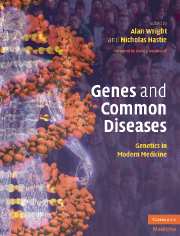Book contents
- Frontmatter
- Contents
- List of Contributors
- Foreword
- Section 1 Introductory Principles
- Section 2 Common Medical Disorders
- 13 Developmental disorders
- 14 Genes, environment and cancer
- 15 The polygenic basis of breast cancer
- 16 TP53: A master gene in normal and tumor suppression
- 17 Genetics of colorectal cancer
- 18 Genetics of autoimmune disease
- 19 Susceptibility to infectious diseases
- 20 Inflammatory bowel diseases
- 21 Genetic anemias
- 22 Genetics of chronic disease: obesity
- 23 Type 2 diabetes mellitus
- 24 Genetics of coronary heart disease
- 25 Genetics of hypertension
- 26 Obstructive pulmonary disease
- 27 Skeletal disorders
- 28 The genetics of common skin diseases
- 29 Molecular genetics of Alzheimer's disease and other adult-onset dementias
- 30 Major psychiatric disorders in adult life
- 31 Speech and language disorders
- 32 Common forms of visual handicap
- 33 Genetic and environmental influences on hearing impairment
- 34 Pharmacogenomics: clinical applications
- Index
- References
13 - Developmental disorders
Published online by Cambridge University Press: 17 August 2009
- Frontmatter
- Contents
- List of Contributors
- Foreword
- Section 1 Introductory Principles
- Section 2 Common Medical Disorders
- 13 Developmental disorders
- 14 Genes, environment and cancer
- 15 The polygenic basis of breast cancer
- 16 TP53: A master gene in normal and tumor suppression
- 17 Genetics of colorectal cancer
- 18 Genetics of autoimmune disease
- 19 Susceptibility to infectious diseases
- 20 Inflammatory bowel diseases
- 21 Genetic anemias
- 22 Genetics of chronic disease: obesity
- 23 Type 2 diabetes mellitus
- 24 Genetics of coronary heart disease
- 25 Genetics of hypertension
- 26 Obstructive pulmonary disease
- 27 Skeletal disorders
- 28 The genetics of common skin diseases
- 29 Molecular genetics of Alzheimer's disease and other adult-onset dementias
- 30 Major psychiatric disorders in adult life
- 31 Speech and language disorders
- 32 Common forms of visual handicap
- 33 Genetic and environmental influences on hearing impairment
- 34 Pharmacogenomics: clinical applications
- Index
- References
Summary
An understanding of the complex processes that underlie the transition from zygote to newborn infant remains one of the major unsolved challenges in human biology. Failure of key steps in early embryogenesis leads to arrested development and embryonic wastage in a substantial proportion of conceptions (Wilcox et al., 1999). Interference with later developmental pathways which mediate the processes of morphogenesis and organogenesis can also lead to fetal demise but equally can produce a phenotypic effect evident at term. This chapter discusses, with selected examples, our current understanding of the influence that genetic and environmental factors have on these complex developmental processes in humans.
The medical significance of developmental disorders
Developmental disorders in humans are diverse in nature and individually relatively rare, but as a group constitute a “common disease”. Improvements in their recognition and pathogenesis, both as isolated entities and as components of syndromes, have been greatly aided by advances in the clinical speciality of dysmorphology and the construction of clinical databases which catalogue rare associations of phenotypic features (Donnai and Read, 2003).
The overall birth prevalence of disorders which are primarily considered to be due to defective morphogenesis is estimated to be between 2 and 3% (Kalter and Warnaky, 1983). If malformations associated with still births and abnormalities which do not present a requirement for significant medical intervention are included in this estimate, the figure rises to ∼ 5%.
- Type
- Chapter
- Information
- Genes and Common DiseasesGenetics in Modern Medicine, pp. 201 - 212Publisher: Cambridge University PressPrint publication year: 2007



